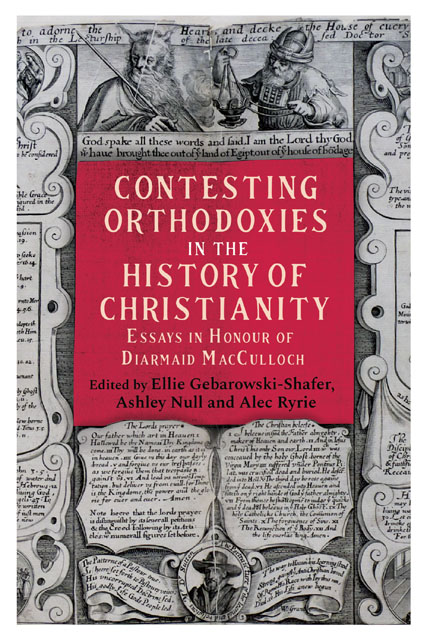Book contents
- Frontmatter
- Contents
- List of Illustrations
- List of Contributors
- List of Abbreviations
- Introduction
- 1 ‘Jewish Christianity’ in Antiquity: Meaningless Category or Heuristic Irritant?
- 2 ‘Sola Fide’: the Wrong Slogan?
- 3 Both Cromwellian and Augustinian: the Influence of Thomas Cromwell on Reform within the Early Modern English Austin Friars
- 4 Lex, Rex and Sex: The Bigamy of Philipp of Hesse and the Lutheran Recourse to Natural Law
- 5 The Authority of Scripture in Reformation Anglicanism: Then and Now
- 6 Orthodoxy and Heresy in the Post-Reformation
- 7 Profanity and Piety in the Church Porch: the Place of Transgression in Early Modern England
- 8 Writing on the Walls: Word and Image in the Post-Reformation English Church
- 9 The Myth of the Church of England
- 10 Mysticism, Orthodoxy and Reformed Identity before the English Revolution: the Case of John Everard
- 11 Sacrilege and the Sacred in England’s Second Reformation, 1640–1660
- 12 ‘I had not the patience to be quiet’: Arthur Bury and The Naked Gospel
- 13 ‘A soul-corrupting indifferentism’: the Intellectual Development of Benjamin Henry Latrobe
- 14 Newman, Dogma and Freedom in the Church
- 15 ‘Tommy, ’ow’s yer soul?’ Reconsidering Religion and the British Soldier
- 16 The King James Vulgate
- 17 The Myth of the Anglican Communion?
- Select bibliography of Diarmaid MacCulloch’s scholarly publications
- Bibliography
- Index
- Tabula Gratulatoria
- Studies in Modern British Religious History
7 - Profanity and Piety in the Church Porch: the Place of Transgression in Early Modern England
Published online by Cambridge University Press: 09 January 2024
- Frontmatter
- Contents
- List of Illustrations
- List of Contributors
- List of Abbreviations
- Introduction
- 1 ‘Jewish Christianity’ in Antiquity: Meaningless Category or Heuristic Irritant?
- 2 ‘Sola Fide’: the Wrong Slogan?
- 3 Both Cromwellian and Augustinian: the Influence of Thomas Cromwell on Reform within the Early Modern English Austin Friars
- 4 Lex, Rex and Sex: The Bigamy of Philipp of Hesse and the Lutheran Recourse to Natural Law
- 5 The Authority of Scripture in Reformation Anglicanism: Then and Now
- 6 Orthodoxy and Heresy in the Post-Reformation
- 7 Profanity and Piety in the Church Porch: the Place of Transgression in Early Modern England
- 8 Writing on the Walls: Word and Image in the Post-Reformation English Church
- 9 The Myth of the Church of England
- 10 Mysticism, Orthodoxy and Reformed Identity before the English Revolution: the Case of John Everard
- 11 Sacrilege and the Sacred in England’s Second Reformation, 1640–1660
- 12 ‘I had not the patience to be quiet’: Arthur Bury and The Naked Gospel
- 13 ‘A soul-corrupting indifferentism’: the Intellectual Development of Benjamin Henry Latrobe
- 14 Newman, Dogma and Freedom in the Church
- 15 ‘Tommy, ’ow’s yer soul?’ Reconsidering Religion and the British Soldier
- 16 The King James Vulgate
- 17 The Myth of the Anglican Communion?
- Select bibliography of Diarmaid MacCulloch’s scholarly publications
- Bibliography
- Index
- Tabula Gratulatoria
- Studies in Modern British Religious History
Summary
When laypeople join in the process of contesting orthodoxy and orthopraxy, their interventions are often focused on specific places – whether church buildings or their own bodies. This essay explores one such liminal site of contention: the early modern English church porch, a no-man’s-land whose multiple uses suggest that orthodoxy could be whatever individuals chose to make it. A church porch was, or could be, both a practical storage site and God’s antechamber. That ambiguity – and the practical control laypeople exercised over it – made this a sliver of orthopraxy in which theologians and hierarchies were never dominant. They were even a site for sexual encounters, which were commoner in churches and church porches than anyone liked to admit in early modern England. Sex in churches and porches often plainly had a certain frisson to it, not least when – as in the cases of homosexuality which the essay documents – it openly defied long-established doctrine.
We think of churches as tidy. Outside is the profane world – literally pro fanum, before the temple – inside is consecrated space, devoted to God. But this expectation of tidiness is a product of modernity, so we must begin by resetting our expectations. Early modern spaces were characteristically porous, and churches were among the most porous of all. The holy was full of holes, as leaky as a sieve, with sacredness spilling out and profanity seeping in, mixing promiscuously together.
In this essay I want to consider how society organised the boundary between the sacred and profane in a time and place – early modern England – when transgression was the rule rather than the exception. In particular, I want to consider one particular space intended to regulate transit: the doorway or porch of the church. In a famous passage, Mircea Eliade made church doors a symbol of the distinction between the sacred and the profane which, for him, formed the basis of religion.
For a believer, the church shares in a different space from the street in which it stands. The door that opens on the interior of the church actually signifies a solution of continuity. The threshold that separates the two spaces also indicates the distance between two modes of being, the profane and the religious. The threshold is the limit, the boundary, the frontier that distinguishes and opposes two worlds – and at the same time the paradoxical place where those worlds communicate, where passage from the profane to the sacred world becomes possible.
- Type
- Chapter
- Information
- Contesting Orthodoxies in the History of ChristianityEssays in Honour of Diarmaid MacCulloch, pp. 120 - 137Publisher: Boydell & BrewerPrint publication year: 2021



